Keyword research uses SEO software to identify words and phrases that people search for in search engines like Google, Bing, and DuckDuckGo. It allows SEO professionals, marketers, and business owners to determine a keyword’s monthly search volume, keyword difficulty (how competitive a keyword is), the cost to purchase the click from Google Ads and identify search trends.
How to do keyword research?
Let’s get into the nitty-gritty. How do you research keywords? Although there are dozens of keyword research tools, I’ll focus on two of the most popular ones in this article: Semrush and Ahrefs.
Preparing your keywords for Semrush or Ahrefs
Before you dive into keyword research with your chosen tool, it’s helpful to have a general idea of what you’re aiming to find.
Create five to ten seed keyword categories (‘seed keywords’ are terms that you will start with to unlock a more specific range of keywords) for which you want to rank. These keywords should be broad topic clusters relevant to your business. They relate to the products or services you sell or topics you think your target audience will engage well with.
For example, if your business sells sportswear, seed keywords could be:
- Running shoes.
- Athletic clothing.
- Exercise.
- Activewear.
- Yoga pants.
- Compression shirts
- Fitness.
- Wellbeing
It’s important to be broad at this stage. Remember that these aren’t necessarily the keywords that you’ll rank for. They’re a starting point (a “seed”) that you can use to grow your keyword strategy.
Once you have a basic list relevant to your business, choose a tool and start. I’ll cover Semrush first, followed by Ahrefs.
How to do keyword research using Semrush?
Let’s start with Semrush. We’ll use “running shoes” as our seed keyword and show you how you can expand on this to build out a list of short and long-tail keywords for SEO.
Semrush’s Keyword Overview Tool
The best place to start is with the Keyword Overview section. You can find it on the left side of the Semrush dashboard.

Enter one of your chosen topic buckets in the search bar from there. We’ll enter “running shoes” and click Search. You should also localise the search to your location. In this case, we’ve chosen Australia.
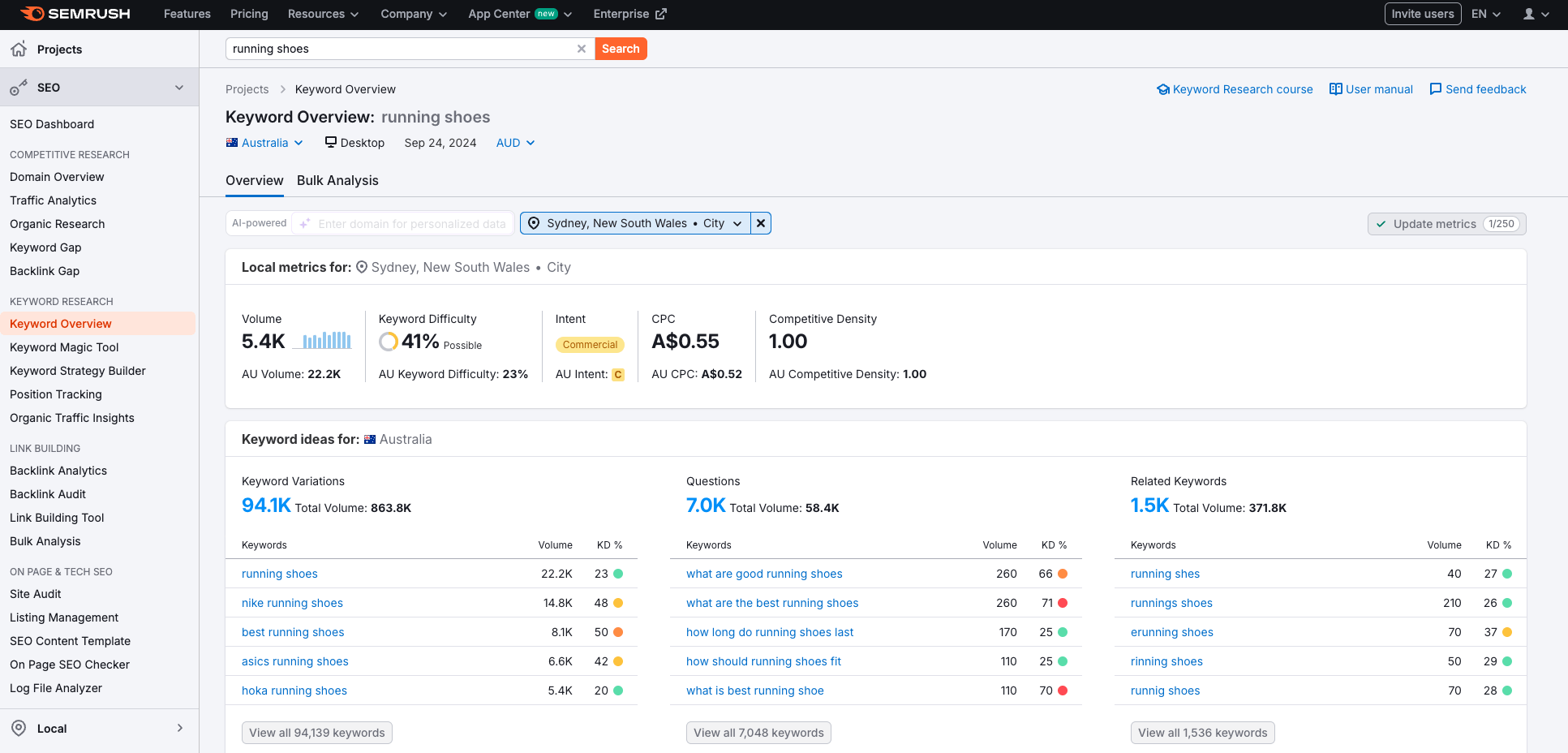
In this overview, you can see all essential information about your seed keyword on a single page, such as:
- Search volume: The number of users searching for the keyword. A high search volume is a good thing for your seed keyword. It shows that there’s a lot of interest in the term.
- Keyword difficulty: How hard it will be to rank for this term based on the amount of competition: Very easy, easy, possible, difficult, hard, very hard.
- CPC: Cost-per-click advertisers will pay to run Google Ads.
- Intent: Is the keyword’s intent informational, navigational, transactional, or commercial? This will help you narrow down content ideas.
- Competitive density: Semrush ranks every keyword on a scale of 0 to 1 based on how dense the competitive landscape is for that term.
Semrush’s Keyword Overview Tool also shows useful things like:
- Keyword variations
- Question-based queries.
- Related keywords.
At this stage, you needn’t worry too much about the metrics, as you’re only evaluating your seed keyword.
Semrush’s Keyword Magic Tool
Next, it’s time to use the Keyword Magic Tool, which is on the left navigation bar, to find related keywords to our main topic buckets.
Once you input your seed keyword, e.g. “running shoes,” you’ll see a page like this.

This keyword research tool lists keywords and phrases related to your seed keyword. Next to each keyword, you can easily view the intent, search volume, and keyword difficulty.
For instance, you’ll see that the related long-tail keyword “best running shoes” has commercial intent, a search volume of 8,100, and a keyword difficulty of 50.
Semrush also offers several ways to refine your search. These are located on the top bar above your keyword list.
For example, you can apply that filter if you’re looking to write informational content. Here’s what that does to our seed keyword:

Now we’re getting somewhere. To find keywords we can rank for as a new sportswear business, we can filter the keyword difficulty from lowest to highest or vice versa.
In this example, I’ll choose something with a low keyword difficulty and a higher search volume to find a keyword that isn’t too competitive but still has decent search traffic. Like this:

In the example above, the keyword “barefoot running shoes Australia” could be a potential winner due to the following data points:
- 140 searches per month.
- A KD score of 6.
Expert tip: As a general rule, you should aim for keywords ‘Easy’ and ‘Very Easy’ when you’re just starting. As you build more domain authority, you can begin to target more difficult keywords over time, which helps you build up topical authority.
Sometimes, when you’re doing keyword research, you may run into cases where keywords are not so relevant to your business. In this case, you can also use the Exclude Keywords function to remove those keywords from your list and click “Apply.” Like this:

Repeat this process for your remaining seed keywords and export the data to a spreadsheet. Once you have a large list of keywords to target, move on to the section below about organising and prioritising keywords.
Semrush Competitor Analysis
Another valuable way to find useful keywords is through Semrush’s Competitor Analysis. It involves analysing your direct competition to see what your opposition is targeting.
To get started, determine who your primary organic competitors are. If you are unsure, you could also search for the keyword using Google Chrome’s Incognito function, like this:
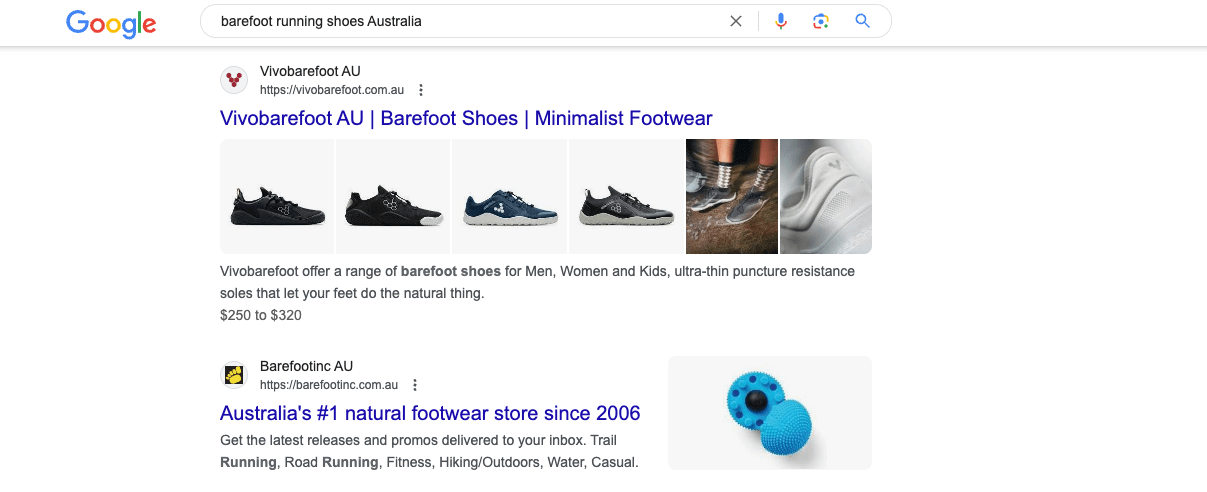
It’s useful using Incognito as some of your competition may fall into two different brackets:
- Direct competitors: You both offer the same service or products.
- Indirect competitors: You provide different products and services and compete for similar keywords.
From there, head to the Domain Overview section in Semrush and enter the competitor’s main URL. Let’s say we land on Vivobarefoot as our primary sportswear rival.
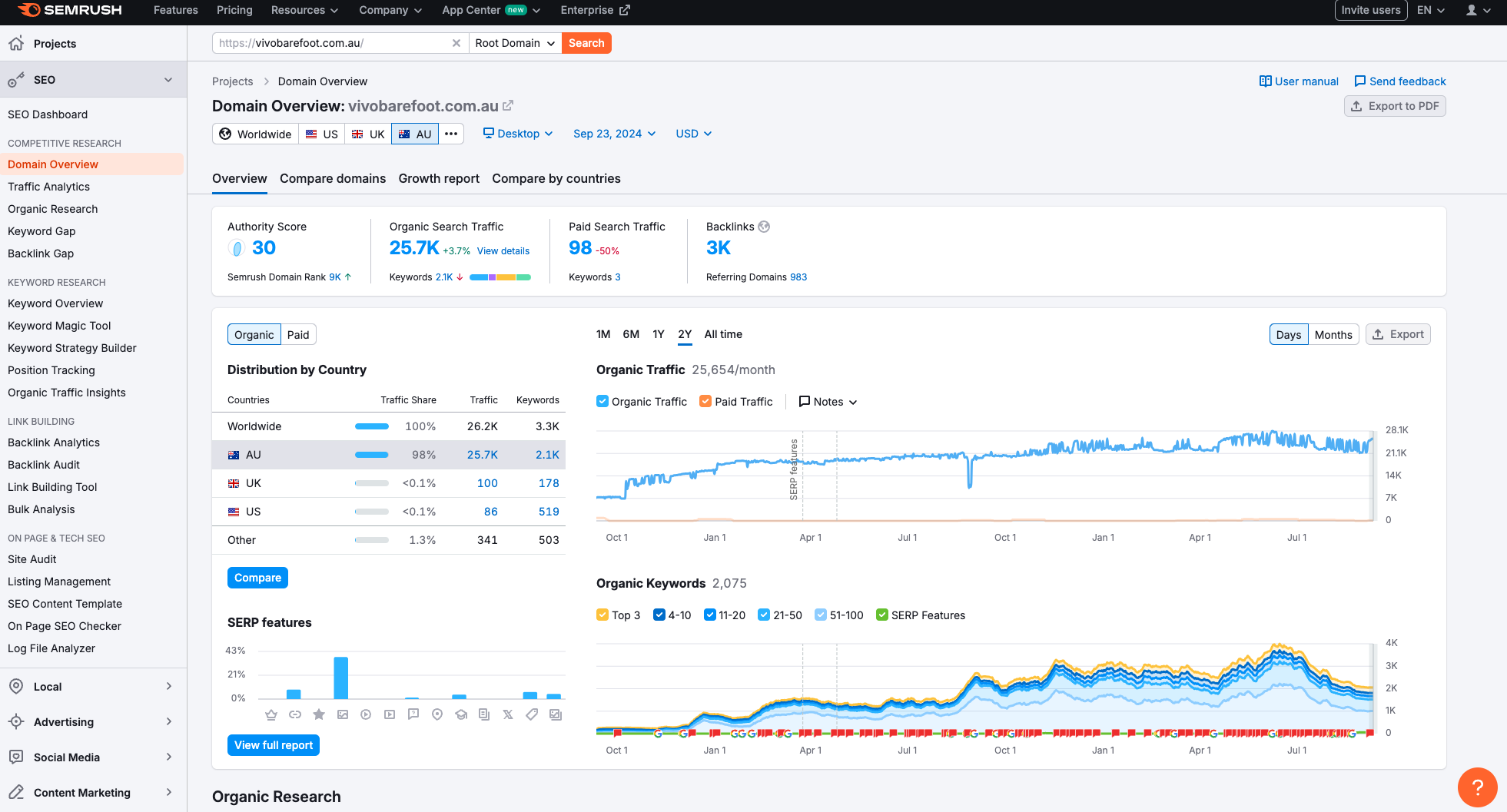
You can also scroll down, and the Domain Overview will show you the Main Organic Competitors and a Competitive Positioning Map.

In the Organic Research section, click View Details to view your competitor’s Top Organic Keywords. Like this:

Then, it’ll show you a bunch of keywords your competitors are targeting. Like this:
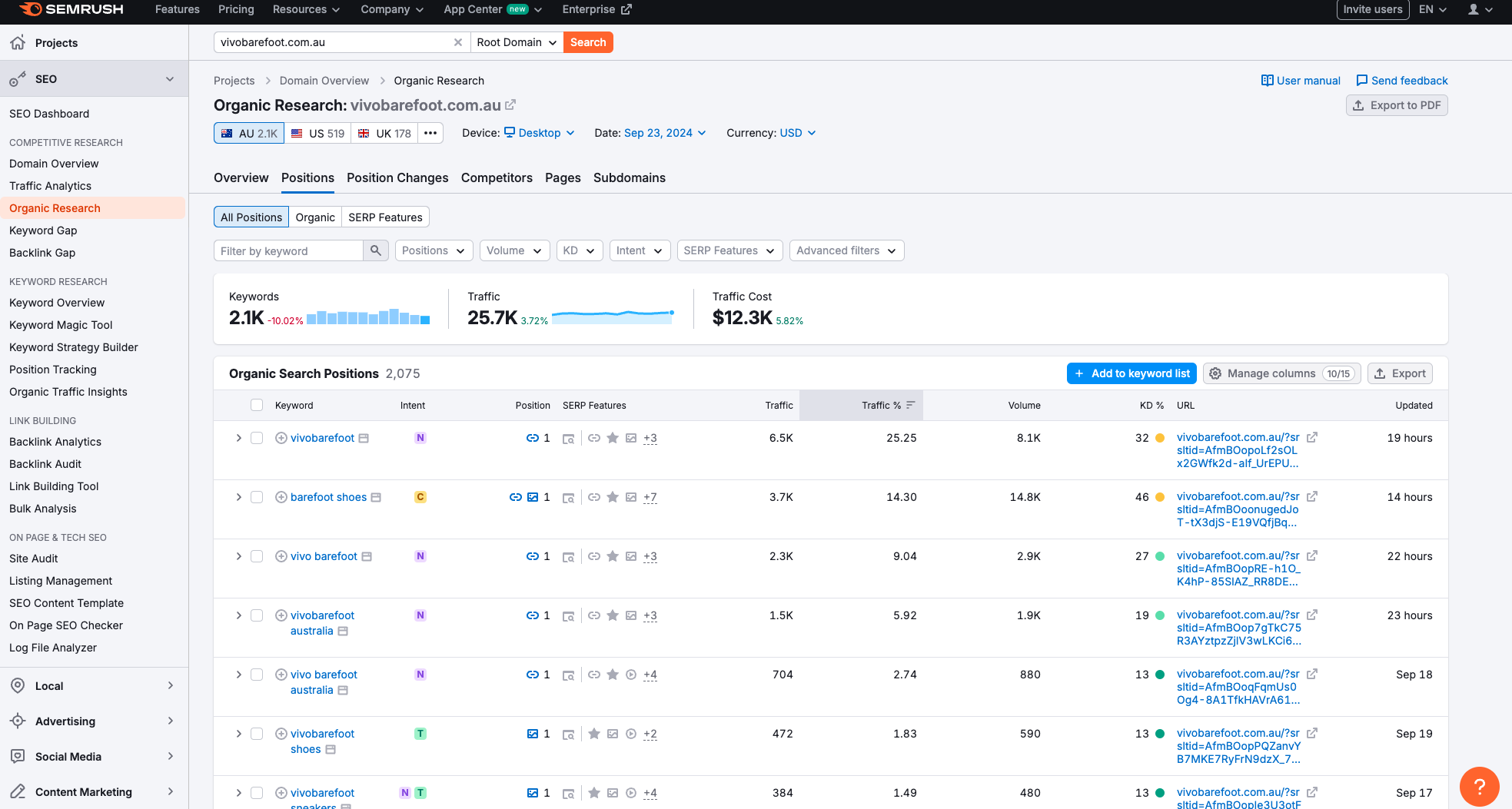
This page shows valuable information such as organic search traffic, internal links, backlinks, and a website’s Authority Score. But for this guide, we’re interested in the Top Organic Keywords section.
After clicking View All, we can see over 2,100 different keywords for which our competitors rank. You could also investigate competitors more deeply by entering their website URLs into Organic Research or conducting a Keyword Gap Analysis to find keywords your competitors are targeting that you don’t currently target, like this:

At this point, we can refine our search by volume, keyword difficulty, and intent to land on potential keywords we can target in our own SEO strategy.
Expert tip: If you are unsure where to start with keyword research, starting off with competitors is an excellent way to speed up your process and get started immediately.
How to do keyword research using Ahrefs?
Ahrefs also offers a tool for finding relevant long-tail keywords to target. We’ll use the keyword “digital marketing” to show you how the platform works.
Ahrefs Keyword Explorer tool
First, go to the Keyword Explorer and enter your seed keyword. In our case, we’ll use the keyword “digital marketing.” Like this:

Then, click the dropdown next to the search bar to choose your location to localise your data. Like this:

As you can see, Ahrefs shows all essential information about your seed keyword, like:
- Keyword difficulty: How hard this keyword will be able to rank for.
- Search volume: How many people search for the keyword you’ve provided? The higher the search volume for your seed keyword, the better.
- Traffic potential: The total organic traffic the number one-ranked page gets for your target keyword.
How to find niche keyword ideas using Ahrefs?
Once you’ve validated your seed keyword, it’s time to find relevant long-tail keywords that are easier to rank for.
In Keywords Explorer, on the left dashboard, click Matching Terms. Like this:

You can also click Related Terms to get a wider range of matches broadly related to your seed keyword. Like this:

At this point, you can view a list of keywords and important metrics, like:
- KD: Keyword difficulty score for ranking.
- SV: Average monthly search volume.
- Growth: Percentage increase or decrease in keyword popularity over time.
- M/D: The monthly search volume is divided by difficulty.
- GSV: Global search volume for a keyword.
- TP: Traffic potential for a keyword.
- GTP: Global traffic potential estimate.
- CPC: Cost per click in advertising.
- CPS: Cost per sale in marketing.
- Parent Topic: Broader category for related keywords.
These keywords can also be filtered by Clusters by Parent Topic:
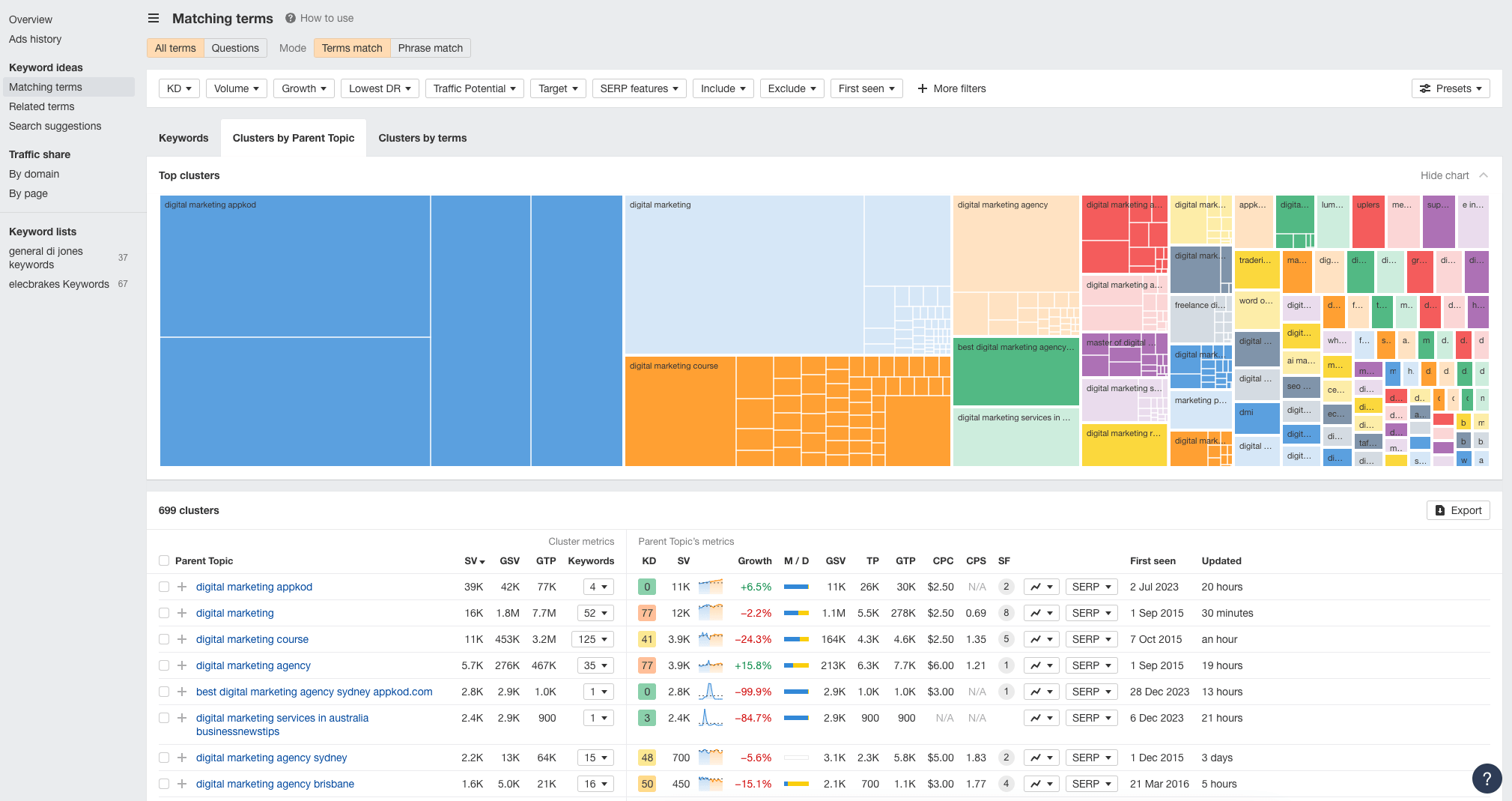
For the keyword “digital marketing,” we can see a total of 12,000 searches per month.

Let’s narrow this down by using the Ahrefs DR function, which allows you to add a low DR number to find less competition. In this case, I’m going to enter in DR 30 in the top 5 like this:

Now, it’s provided me with a list of keywords, but this still needs some refining as it shows some brand names and other keywords that are not very relevant.
So, I’m going to use the Exclude function to clean up this data like this:

Now, you can click on the filters, for example, KD to sort by lowest KD or SV to sort by the highest search volume to see if there’s anything worth targeting. Here’s what the filtered keyword list looks like now:

In the keyword list above, some potential strong candidates for digital marketing agencies and online course providers exist. Here are some of the keywords that stand out from this list that could be whitelisted:
| Keyword | Keyword Difficulty (KD) | Search Volume (SV) |
| Digital marketing specialist | 3 | 350 |
| Course digital marketing | 15 | 150 |
Ahrefs Site Explorer
Another way to find seed keywords is to use Ahrefs’ Site Explorer to analyse your competitors’ rankings. For example, let’s say you’re a small business in India competing with Swiggy, one of India’s largest online food delivery platforms.
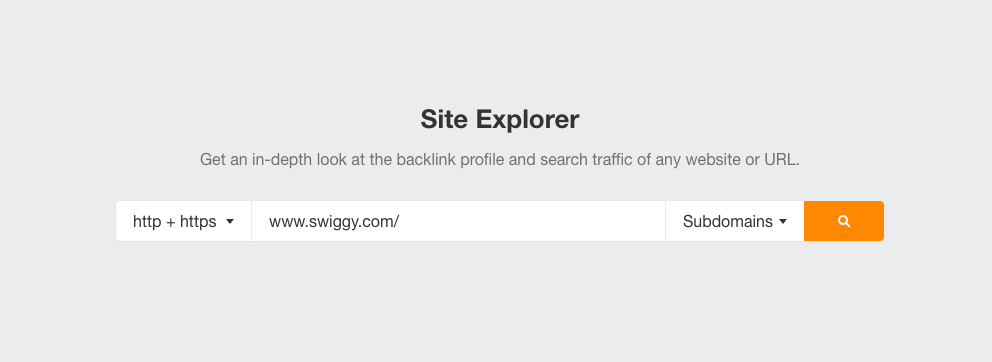
Start by clicking Site Explorer at the top of the Ahrefs dashboard. Then, enter the URL of one of your direct competitors. In this case, I’ll enter in Swiggy’s URL.
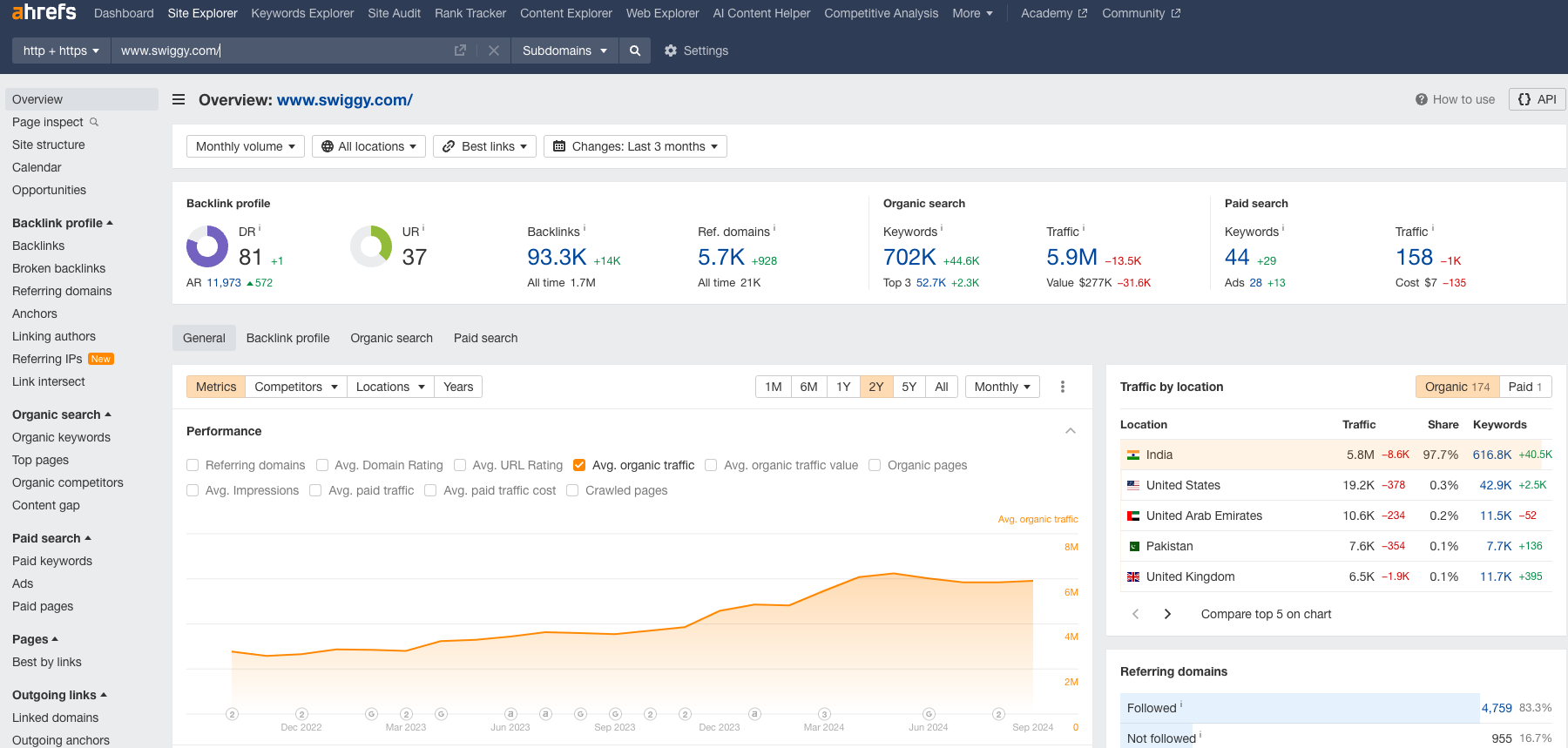
Here, we can see all the essential information about our competitors. For now, let’s click on Organic Keywords on the left-hand dashboard.
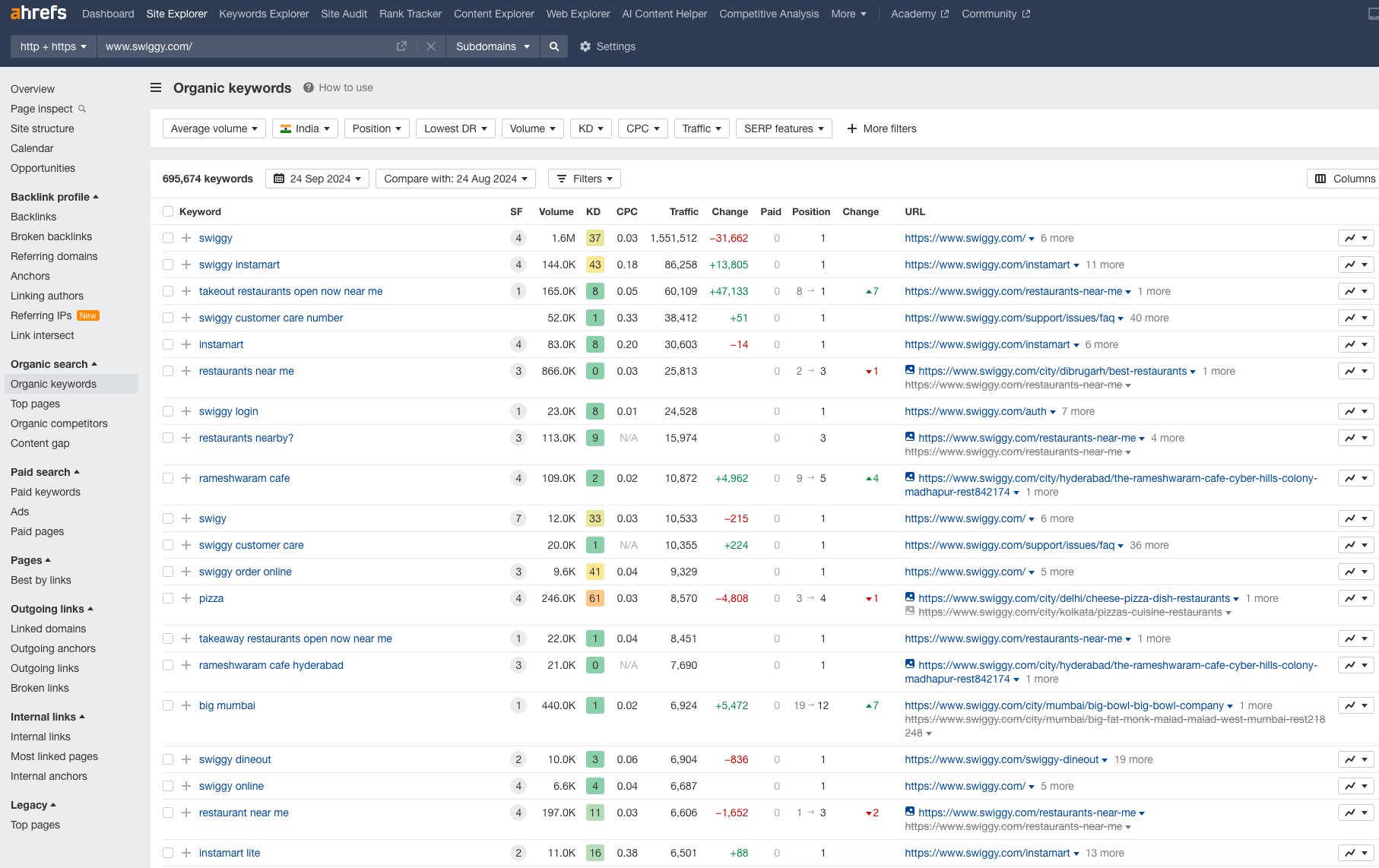
We can now see thousands of keyword variations for which Swiggy ranks and how well the company ranks in Google search results for each keyword.
We can refine our search by intent, difficulty, and volume to find the best keywords for our content strategy.
This is a different approach to using Ahrefs keyword explorer, but the result is the same: a list of high-quality keywords that you can use to create valuable content and drive traffic to your page.
What are keywords?
Keywords, often referred to as SEO keywords, are the words and phrases people use in search engines to find information, products, and services across various topics.
A keyword is anything a user searches for in a search engine.
For example, if someone searches for “AI agents,” this is a keyword. Then, on the search engine results page (SERPs), a search engine like Google will show a relevant response for that keyword. Like this:
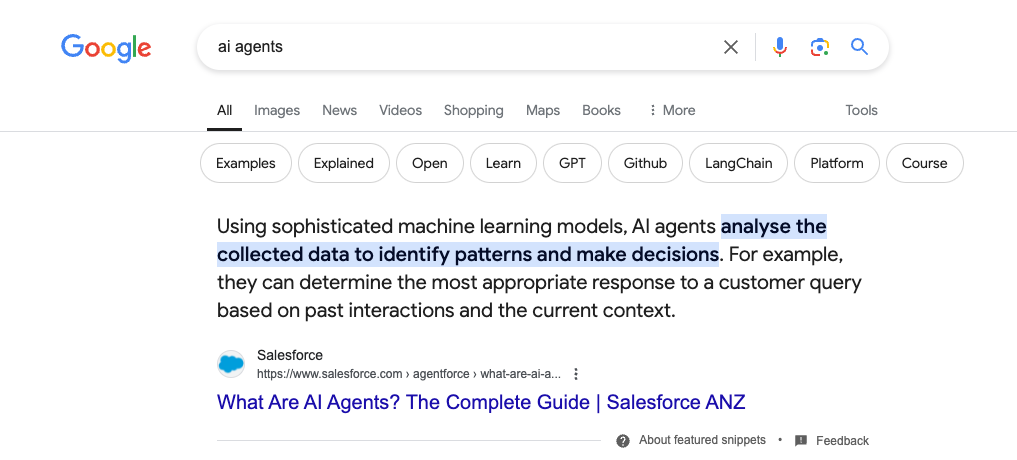
In the case of the example above, this is called a featured snippet, which is when a search engine displays a text-based answer to a user’s search query. Google sourced the featured snippet above from an article we created on Salesforce using keyword research targeting the keyword AI agents.
In the AI agents keyword example, the article was created to target two main keywords:
- A primary keyword: AI agents.
- A semantic keyword: What is an AI agent?
When SEO professionals conduct keyword research, they often target both a primary and semantic keyword (related keyword) for one piece of content, which can potentially rank for a cluster of keywords (multiple keywords).
Let’s say a piece of content is already live and ranks on page 1 of the search engine results page (SERP).
In that case, you can view the cluster keywords on Ahrefs by entering a URL (or a competitor’s URL) into Ahrefs Site Explorer and clicking on “exact URL” to show the keywords for which a specific page is currently indexed, then click on “Keywords.” Like this:

Here’s a table that I’ve created to help illustrate the difference between a primary and a semantic keyword more clearly:
| Type of Keyword | Keyword |
| Primary keyword | AI agents |
| Semantic keyword | What is an AI agent |
In the case above, the article targets a primary (main) keyword and two semantic keywords. Since it was recently published, it will likely be indexed for more semantic keywords when Ahrefs crawls it again.
Types of keywords
Generally speaking, keywords can be categorised into two main types these being short-tail and long-tail keywords:
| Keyword Type | Explanation | Example |
| Short-tail keywords | 1-2 words in length | Keyword research |
| Long-tail keywords | Longer phrases | Keyword research ideas for beginners |
Expert tip: It’s pretty common to hear SEO professionals, content editors, and digital marketers talk about content optimisation using latent semantic indexing (LSI) keywords — but this is not keyword research. Instead, LSI keywords are elements involved in the content briefing process after identifying a primary keyword for creating or optimising content.
Semantic keywords
A semantic keyword is a keyword(s) that are directly related to a primary keyword. For example, if someone is searching for “CRM,” then semantic keywords for this could be things like:
- CRM
- CRM meaning
- What is a CRM
- CRM platform
- etc
Expert tip: When you’re doing keyword research, a page often has the potential to rank for multiple keywords, i.e., keyword clusters. This means you won’t need to create an individual page for each keyword; instead, one page can target multiple keywords simultaneously. Like this:

Using Ahrefs Site Explorer in the CRM example above, the page is indexed for 369 keywords. This indicates it ranks for a primary keyword (the keyword with the highest search volume) and a cluster of semantic keywords (in this case, 368 keywords minus the primary keyword).
Why does keyword research matter?
SEO keyword research tells you what your target audience is looking for online, meaning you can create content that includes those words and phrases.
This helps you climb higher on the search engine results page. Why does that matter? On average, the highest-ranked site for a given search term gets the most traffic 49% of the time. In short, the more you can climb the rankings, the more people visit your site.
While it’s entirely possible to guess what your audience is searching for online, there are two problems with this strategy:
- If you target a keyword that isn’t popular enough, your SEO strategies might not make an impact.
- If you target a popular keyword, you might need help to stand out from the competition.
Keyword research helps you discover the perfect SEO middle ground between “too hard to rank for” and “not enough monthly search volume.” It lets you find valuable keywords that will bring traffic to your site without going to war with a million competitors. This increases your chance of targeting keywords that drive serious results for your business.
Keyword research for SEO: Learning the SEO basics
Reviewing a few basic concepts is essential before diving into our guide to keyword research.
Short-tail keywords vs long-tail keywords
Short-tail keywords are shorter, more generalised phrases, like “furniture,” “digital marketing” and “running shoes.” As you can imagine, these generic keywords generate a lot of traffic. If you rank on the first page of Google for one of these search queries, break out the champagne.
The problem? Because short-tail keywords are generic, there’s a lot of competition. It’s also challenging for Google to work out the user’s search intent, increasing the competition you need to contend with.
For instance, consider the number of unique search results for a term like “running shoes”.

808,000,000 pages are many competitors to fight off when starting. For this reason, many business owners also like to incorporate long-tail keywords into their content.
Long-tail keywords are longer phrases containing three or more words. They are much more specific and have a lower search volume than short-tail keywords. That said, there’s much less competition for these key-phrases, meaning they’re far easier to rank for.
Examples of this keyword type include “furniture ideas for small living rooms,” “digital marketing guide for newbies,” and “soft running shoes for concrete roads Australia.” Watch what happens when we enter the latter term into Google.

That’s 808,000,000 results for “running shoes” down to just 1,160,000. And, considering 96.55% of content on Google gets no traffic at all, the odds of making an impact just got far greater.
Does this mean you should only target long-tail keywords? Not at all. Most SEO experts prefer to choose a mixture. High-volume short-tail keywords are great for boosting topical authority over the long term. Lower-volume long-tail keywords are good for capturing short-term niche traffic. Develop a keyword strategy with both variations in mind.
Understanding a user’s search intent
Next, you need to understand keyword intent. This is all about stepping into the shoes of your target audience to determine what they’re looking for when they search for something online.
In general, there are four reasons a consumer heads to Google.
- Informational: The user wants to learn something, such as entering “what is keyword research” or “how to deep clean an oven.”
- Navigational: The user wants to find a specific company or website, such as by typing in “Gmail login” or “Salesforce CRM.”
- Commercial: The user is comparing options to make a decision. For example: ‘The best pet food for dogs in 2024’ or ‘iPhone 13 vs Samsung S23.’
- Transactional: The user is ready to take action, such as buying Nike shoes or Netflix subscription plans.
This is crucial knowledge because it informs the type of content you’ll create for your audience.
I spoke with Chris Haines, a Senior SEO Specialist at Ahrefs, to get his thoughts on how search intent has changed. Here’s what he had to say:
“Search intent can often be more nuanced than informational, navigational, transactional and commercial, and that’s where a tool like Ahrefs’ SERP Overview can help you pinpoint the exact search intent by percentage.”
“Search intent can also shift over time, so it’s important to check the dominant search intent on older content if you notice rankings have slipped and, if so, rework your content to target the new updated dominant intent.”
If you land on a long-tail keyword like “how to deep clean an oven,” you can determine that the intent behind this search term is informational. This means the content you write to target that keyword should be informational, too.
This approach will ensure that your content always meets your users’ needs, meaning higher customer satisfaction and reduced bounce rates — two things Google loves.
You can also use tools like ChatGTP and Gemini to analyse search intent using a prompt like this: Can you tell me the search intent for {{insert keyword}}?
Like so:
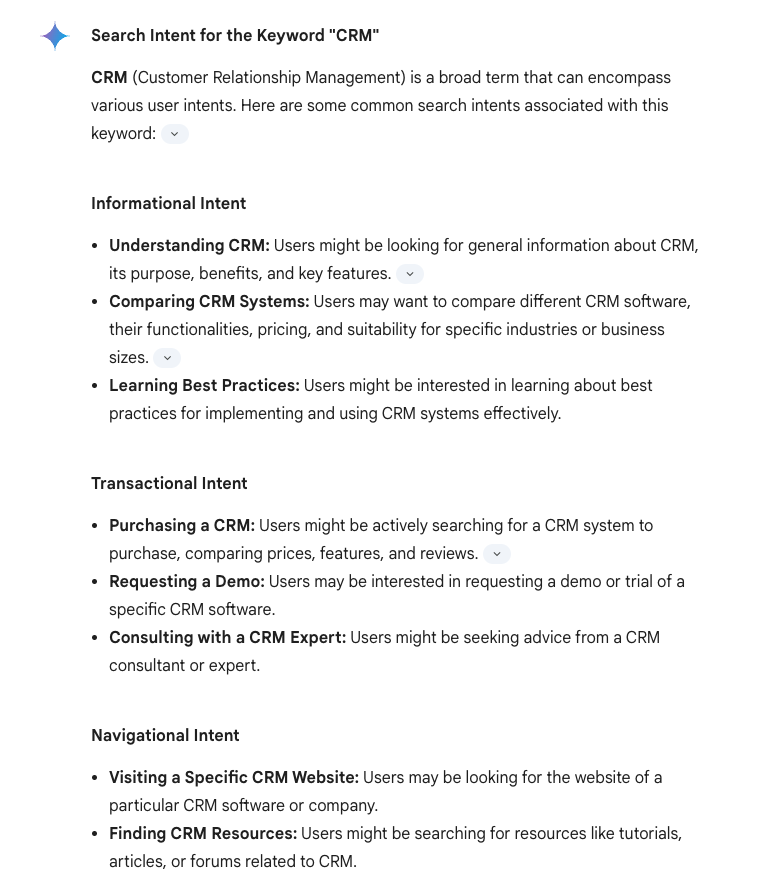
How to organise your keywords?
Generally, the easiest way to create broad keyword clusters is to segment your keywords by intent in a spreadsheet. From there, you can further divide your keywords into predefined topic buckets. This process should result in something like this:
Informational search intent
- Running shoes (seed keyword)
- What are good running shoes [260]
- How long do running shoes last [170]
- How often should you change running shoes [90]
- Exercise (seed keyword)
- Equipment to exercise [1,000]
- Clothes for exercise [880]
- Front delt exercises [880]
Commercial search intent
- Running shoes (seed keyword)
- Running shoes women [2,900]
- Running shoes for men [1,600]
- Carbon plated running shoes [480]
- Exercise (seed keyword)
- Exercise bike [18,100]
- Exercise ball [2,900]
- Exercise bands [1,900]
Organising your keywords allows you to target a single seed keyword at every stage of the buyer lifecycle. This boosts your topical authority for these terms, allowing you to target keywords with a larger search volume (and greater difficulty) further down the line.
How to prioritise your keywords?
Prioritising your keywords is perhaps the most challenging part of keyword research because there isn’t one definitive way to do it. It depends entirely on your goals.
For that reason, I’ve provided several different methods for choosing the best keywords for your business.
- Relevance: Is this keyword truly useful to your business? Will it link back to your product? Is this something your audience would want to know? Prioritise keywords that will be valuable to you and your customers.
- Keyword difficulty: When you’re just beginning to target a seed keyword, prioritise words with a lower difficulty score that are easier to rank for. You can gradually increase the keyword difficulty from there as you gain more topical authority.
- Buyer journey: You can also prioritise keyword targeting based on search intent. For example, many businesses begin with informational content to build topical authority before targeting commercial and transactional phrases.
- Demographics: There’s also the option of evaluating your keywords through the lens of your target market. The more you understand your target audiences, the easier it is to determine which keywords are worth your time.
How to choose optimal keywords based on a region?
Every country has its own unique, relevant keywords. For instance, searching for “best car brands 2024” in Australia will bring up a different list of terms than the same search in India or Singapore.
Take the time to really understand where you’re marketing your business. This will largely influence the effectiveness of different search terms. Here is an example to show this.
Asia Pacific
Singapore’s market is tech-savvy, with a strong focus on premium products. Competition can be fierce in the tech and lifestyle sectors, which means you may want to choose niche and technical keywords.
As such, to expand on the seed keyword ‘smartphones’, you could opt for:
- Smartphone bracelet [140]
- Best smartphone camera [110]
- 32-bit 384khz audio smartphone [90]
- AI features in smartphones [90]
You can see how your region shapes your keyword-based strategy. Here, we have three different markets, each with its own preferences and priorities.
Remember: You can localise your keyword search by adjusting the region in both Ahrefs and Semrush.
Summing up
If you truly want to drive organic traffic to your site, you need to understand what terms your customers are searching for. To do this, you need to make effective keyword research a priority.
Tools like Semrush and Ahrefs will provide you with all the data you need to optimise your content creation. You can evaluate keyword difficulty score, search volumes, and search intent to determine which keywords are worth the investment and which are a waste of time.
Create a list of seed keywords, refine them using tools, and prioritise your keywords based on their value to you and your audience. Do all that, and you’ll be in the perfect position to create valuable content that converts consumers into loyal customers.
How Salesforce can help?
Once your SEO strategy is underway, all that’s left to do is track your performance and refine as you go. Our marketing automation platform will help you analyse the effectiveness of your current campaign and provide personalised recommendations for improvement based on your predefined goals.
Salesforce Marketing Cloud can help you find prospects, guide your buyers down your sales funnel, close more deals, and connect with your audience at every touchpoint. Get ready to deliver exceptional customer experiences across every channel. To find out more, watch the Marketing Cloud Demo today or explore our plethora of exceptional marketing AI tools.









